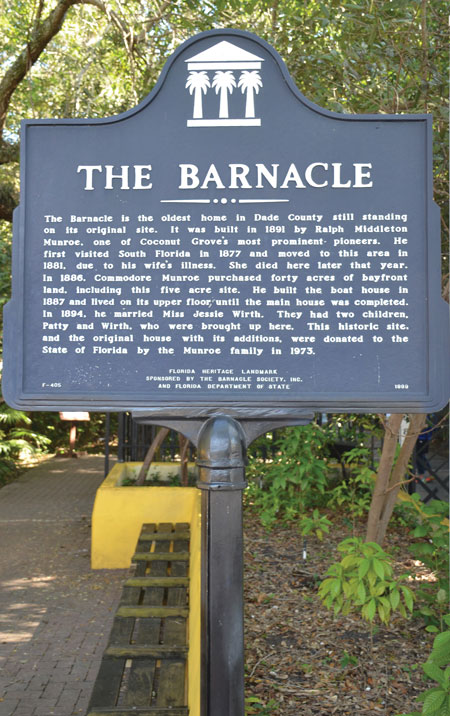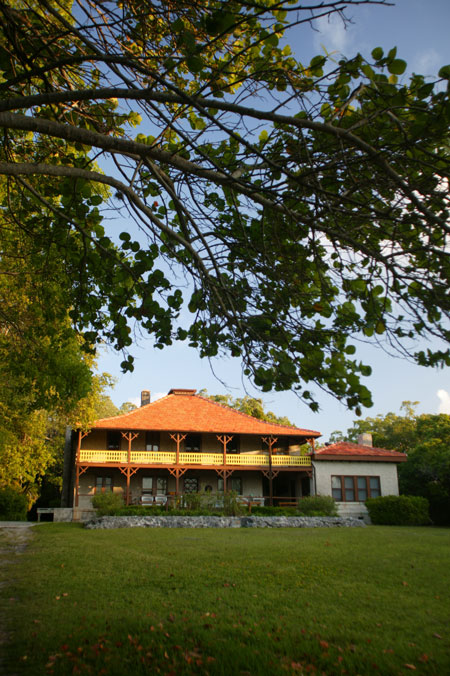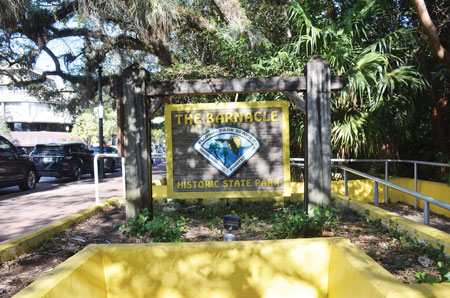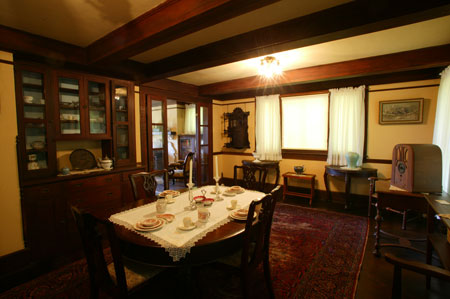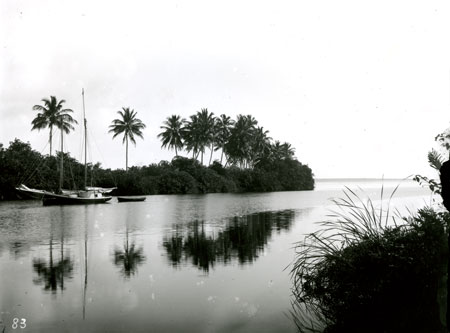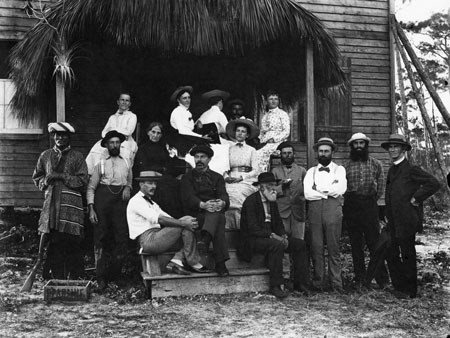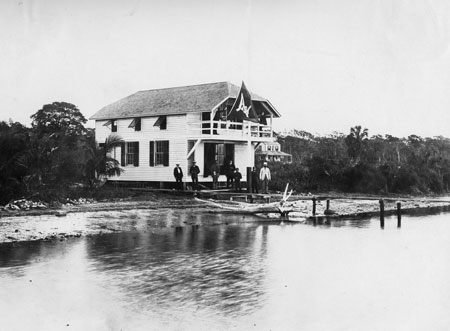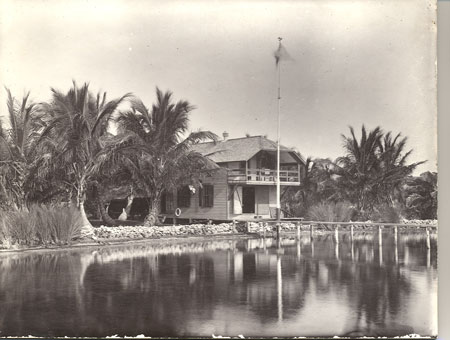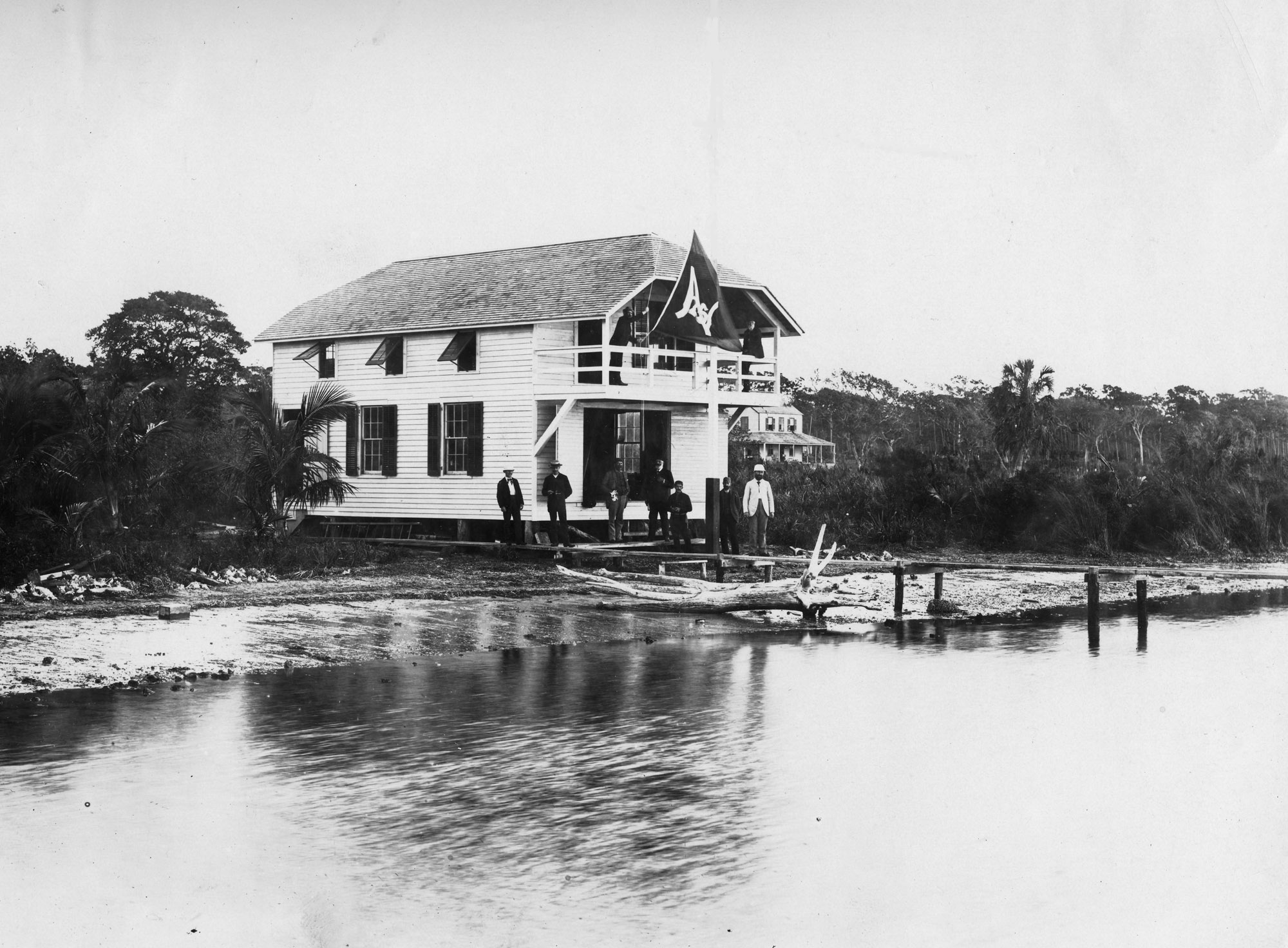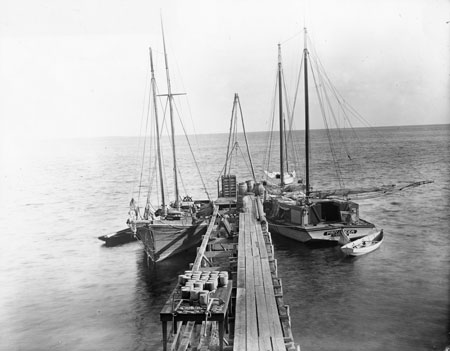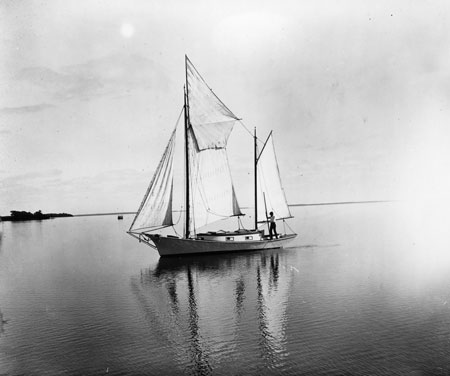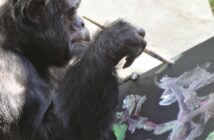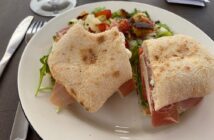Ralph Middleton “Commodore” Munroe (1851-1933), a boat designer and builder, seaman, naturalist, and photographer first saw south Florida in 1877 while vacationing from New York. In the book, The Commodore’s Story: The Early Days on Biscayne Bay, written by Munroe and Vincent Gilpin near the end of the Commodore’s life in 1930, he describes the south Florida he saw in 1887. “It is instructive to note of the points of interest considered worth picturing in 1887. They were almost entirely natural features, the works of man being represented only by a few primitive houses and small sail boats. The Everglades were still an unexplored wilderness.
“The ‘Hunting Grounds’ of Cutler were still the haunt of deer, bear, and panther. Indian Creek was a desolate lagoon, haunt of the wild duck and crocodile.
“The Miami River was a mangrove bordered stream, with four or five small buildings on its whole length. There was no Coral Gables, no Miami Beach, no race track, no golf course, not a single orange or grapefruit grove, nor even the suggestion of a truck farm. There was not a mile of road anywhere, the water of the Bay being the only highway.”
Photo by Bill SumnerHome on the Bay
The home of Ralph Middleton Munroe, the Barnacle, is today a Florida State Park located in the heart of Coconut Grove. Just four miles southwest of Miami’s skyline with its gleaming modern buildings straining for ever-greater height stand his home, boathouse and carriage house just as they were decades ago. One of south Florida’s early settlers, Munroe’s original home site encompassed 40 acres of land along Biscayne Bay. The park is located on five remaining acres of the original tract of land. The land gently slopes downward from the entrance on Main Highway introduced by an old growth hardwood hammock, down to the Barnacle (Munroe’s name for his home), to the boathouse fronting the bay.
The Barnacle, completed in 1891 was built on a ridge within the 40 acres of land he purchased in 1886. The land was first surveyed in 1846 and later homesteaded by others before Munroe’s purchase. He paid $400 plus the trade of his sailboat Kingfish, a sharpie, valued at an additional $400. A sharpie is a traditional fishing boat with centerboards, shallow balanced rudders and straight, flaring sides designed for sailing in tidal waters. The boathouse, constructed in 1887 was the first building designed and built by Munroe to be sited on the property. He lived on the second floor as the Barnacle was being constructed.
Tragedy struck Munroe’s brief, two-year marriage to Eva Emilia Hewitt when she contracted tuberculosis in 1881. It was common practice for doctors to suggest that a change in climate might improve the health of patients with tuberculosis. Recalling the beauty and serenity of Biscayne Bay, Munroe took his wife to stay at an encampment on the Miami River, where she nevertheless, succumbed to the disease. Upon his return to New York, he learned that their infant daughter had also died of tuberculosis while in the care of relatives.
After the loss of his wife and daughter, Munroe journeyed to Biscayne Bay several times between 1882 and 1886. He spent his winters with Charles and Isabella Peacock, owners of the Bay View House, the county’s first hotel, later renamed the Peacock Inn.
New Beginnings
“My parents, Ralph Middleton Munroe and Jessie Wirth, met on their way south from New England each on cruising boats. Mother came with her older sister and brother-in-law and just never went back—she stayed and married Daddy in 1895.” Quoted in 1977 for the publication “Update,” Patty Munroe Catlow recounts the story of her parents’ meeting to historian Jean Taylor in an article entitled, “Growing Up at the Barnacle.”
The Munroes had two children, Patty in 1900 and son Wirth, in 1902. The family continued to live at the Barnacle until 1973 when the site became a state park.
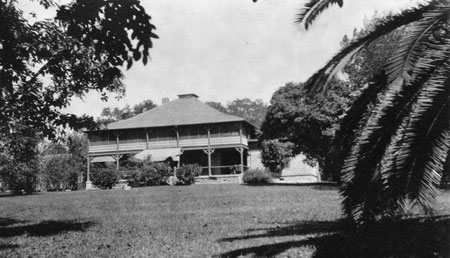
Archival photo of The Barnacle
Amateur Architect
Munroe’s Barnacle was completed in 1891. The original house, a one-story wood frame structure clad in weatherboards was positioned on wood pilings with an octagonal-shaped central room topped by a glass opening to roof. This design allowed for the escape of hot air from the home.
Patty Munroe Catlow describes it: “Among my earliest recollections are the chores I was responsible for when I was five or six years old. We had an octagonal dining room in the center of the house with a skylight above and two windows that opened with long lanyards that came down into the room. It was Brother’s and my job to see that those windows were closed whenever a rain came up or the wind blew too hard.”
In 1908, the house was modified by raising the existing structure and adding below a new first floor (made of molded, faceted concrete blocks). A new library wing was added on the northeast corner several years later. Other alterations to the building include the application of a rough stucco finish to the exterior in 1928 and the enclosure of the verandas on the north and south facades.
The two-story house is an example of vernacular architecture designed to take advantage of the views down to the bay and the bay breezes. The well-detailed and well-crafted building features a broad, hipped roof and wide porches and verandas with an interior layout designed to provide natural ventilation. Designed by Munroe and built by C.J. Peacock, Joe Frow, and Ben Newbold, the Barnacle is one of the oldest surviving structures in Coconut Grove in its original location.
Today, Park Rangers and volunteers give guided tours of the home in which original furnishings and family items are exhibited. Thanks to the ongoing involvement and generosity of the Munroe family, the collection of over 6,000 objects continues to grow enriching the information about daily life at the Barnacle.
Micco under sailLove of Design
“No sea lover could look unmoved on the blue rollers of the Gulf Stream and the crystal-clear waters of the reef, of every delicate shade of blue and green.” (Commodore Munroe)
Life at the Barnacle allowed Munroe to engage in his passion for boat design. Although he was not formally trained as a marine architect, he had been interested in boats since childhood and designed 56 different sailboats in his lifetime. Perhaps, his most famous design was Egret, a 28-foot sharpie ketch that he designed for himself (a working replica of Egret is moored near the boathouse). Munroe both designed and built many of his boats in his Florida boathouse. Another replica on site is a flying proa lofted in the rafters of the visitor pavilion. Munroe built several of these, intrigued by the multi-hull design native to Micronesia. Munroe’s reputation as a designer garnered a visit to the Barnacle in 1918 by Nathaniel Herreshoff, dean of American yachting design. Their friendship and mutual respect grew to such an extent that whenever Herreshoff visited the Barnacle he would stay in the cottage on the property built for him by Munroe.
Munroe never stopped improving on his understanding of architecture. His original boathouse had to be rebuilt after the ravages of the 1926 hurricane. Munroe did so by designing breakaway walls on the two gables and by affixing two guy wires per side wall. He also added steel strapping to the underside of the roof. Fast-forward to Hurricane Andrew in 1992, his design worked, this time the boathouse did not implode from wind pressure thanks to his improvements.
The first George Washington Birthday Regatta on Biscayne Bay, 1887Biscayne Bay Yacht Club
The Biscayne Bay Yacht Club was founded by Munroe in 1887 and he was the club’s first Commodore. He was the Commodore for 22 years. The Washington’s Birthday Regatta was first held on Biscayne Bay on February 22, 1887. For years the club was at the center of social life in the Grove. The Commodore designed the club’s pennant with an emblem of a large letter ‘N’ interlaced with the numbers ‘25’ to signify the fact that it was, at that time, the southernmost yacht club in the US (25 degrees north latitude). Today, the tradition of the Washington Birthday Regatta continues, as well as the Commodore’s Birthday Regatta in early April.
Amateur Photographer and Naturalist
The Commodore was an accomplished amateur photographer who chronicled the natural beauty of Biscayne Bay and the land he so loved. In many instances his photos are the only record available of early 19th century Miami.
Writing in “Update” in 1977 (Vol 4, No. 5, p.2) historian Arva Moore Parks wrote, “Munroe was interested in everything—especially the new world he found in the tropics. Unlike many other pioneers he was not interested in what it might become, but in what it was at that moment.”
To that end, he began photographing his new found land in order to share it with others. Many of his photographs were used in a variety of publications during his lifetime. Collections of his photographs are held by the University of Miami, History Miami, and the Barnacle, among others.
Munroe was one of Miami’s first naturalists. His concern for the environment prompted him to find ways to make a living that would not damage the delicate ecosystem that surrounded him.
“Munroe was one of the few people that was sorry the railroad came to South Florida. His views on protecting the unique environment put him in a position of often “standing alone” against so called progress. This disparity became especially acute with the beginning of the Florida Land Boom…” (“Update” 1977, Vol 4, No. 5, p.3, Arva Moore Parks.)
The BoathouseThe Barnacle Today
The best approach to the site may well be on foot. Once inside the pedestrian gate, one is greeted by the green hammock and the smells and sounds of Miami before it was developed. Guideposts along the route to the house inform visitors about the native flora and fauna surrounding them. First, the carriage house appears on the left. Enter here to get information and visit the gift shop. Next is the Commodore’s house. Wait here on the porch for a tour and while waiting take a good long look at the view that runs down a grassy lawn into the shore below along Biscayne Bay.
The tour with Katrina A. Boler, Park Manager begins at the boathouse. “This bright yellow building was the once the hub of Miami,” she says. We enter through a wooden door and step back in time, yet into a working boathouse. Here, volunteers and students work to build wooden boats to race and for sale. One sale provides the funding to buy the supplies for the next boat and the next crew of student boat-builders. C. Alyn Pruett, First Vice President of the Board of Directors of the Barnacle Society joins us in the boathouse to talk about the upcoming Washington Birthday Regatta, the Commodore’s Birthday Celebration, and other boating-related events that are among the many offered at the Barnacle site.
The Barnacle Society’s Second Vice President, Sweet Pea Ellman also joins us and wants to be sure the word gets out about volunteering opportunities at the Barnacle. “We have special events all the time: concerts, Shakespeare in the Park, yoga by the sea, dancing, you name it.”
Conducting tours of the property and the Barnacle home is another carrot to entice volunteers to spend time educating adults and school groups about the life and contributions of the Commodore and his family.
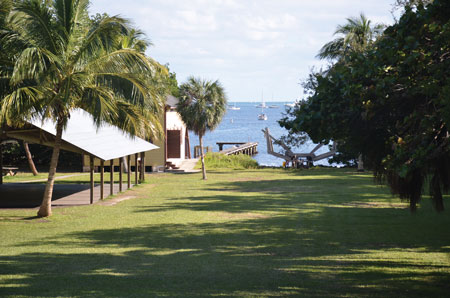
View of the bay from The Barnacle porch (2016)
The Barnacle Society is formed to support and preserve the home of Commodore Ralph Middleton Munroe. Their mission: “A volunteer, non-profit, citizen supported organization created to generate public awareness, education, and financial support for the preservation and maintenance of The Barnacle Historic State Park.”
“We offer so much here at the park. The Park Service thanks the people who make it work: the members of the Barnacle Society, the continued participation of the Munroe family, volunteers, donors, funders, and the interest and enthusiasm of the public,” said Ranger Boler.
The Barnacle, located at 3485 Main Highway, Coconut Grove is open Friday through Monday from 9A to 5P with guided tours scheduled throughout the day. The park is available on Wednesdays and Thursdays for group tours by advance reservation. The park is closed Tuesdays, New Year, Thanksgiving and Christmas days. Please contact the park at 305-442-6866.
Ralph Munroe was something of a Renaissance man who did so much for the community of Coconut Grove. Upon his passing, David Fairchild wrote of Munroe: “Coconut Grove will never be the same again without him. His marvelous personality and historical background made him a kind of cornerstone in the community, and when cornerstones are gone, society loses a great deal more than it usually appreciates.”
Interior photo of the boat house. South Miamian John Palenchar, a Barnacle Board member works with the boatbuilding program, with South Miami High students in Nick Truby’s Construction/Architecture class. Truby is also a resident of South Miami.
THE SOUTH MIAMI VOLUNTEERISM CONNECTION:
BOAT BUILDING & BOARD LEADERSHIP
The South Miami connection is strong here.
Harking back to her family’s generations-strong connection to Coconut Grove, former South Miami mayor and current president of ChamberSOUTH, Mary Scott Russell is completing her two-year term as President of the Barnacle Society Board this April at the time of the Commodore’s Birthday Party Gala.
“I just love The Barnacle. My brother Scott and I grew up in Coconut Grove right around the corner from our grandparents and the Barnacle is one of the few things that has not changed. It is a slice of history that is not stagnant: there are so many offerings for all ages and interests. Just this weekend I was volunteering at the Shakespeare Festival, where more than 400 people enjoyed ‘Much Ado About Nothing’ under a full moon. We have movie nights for everyone from kid’s movies where children come in their pajamas to Hitchcock and other classics and wonderful concerts on the lawn. You can bring a picnic and a bottle of wine, friends and family (my son Max and I have spent countless hours here) and enjoy the sunset and moonrise from your own spot on the lawn overlooking our small fleet of boats on beautiful Biscayne Bay. Enjoy a show or a yoga class by the sea or just bring a book.
“Walk the natural hammock path that leads to Commodore Ralph Munroe’s original home of his own design, built for our climate, just like his finely designed boats. Enjoy the hospitality of the wonderful park staff led by Ranger Katrina Boler and the delightfully knowledgeable Board members and volunteers that support The Barnacle. The Barnacle belongs to you and we
want everyone to feel right at home.”

